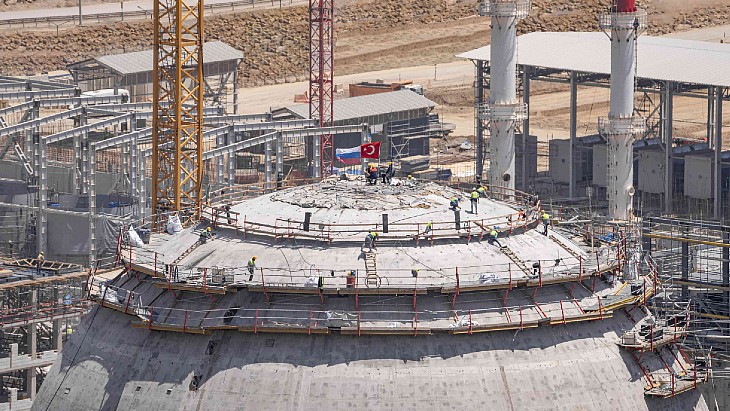Turkey continuing negotiations over new nuclear power plants
11 March 2024
Turkey's Energy Minister Alparslan Bayraktar says it hopes to launch the first unit at Akkuyu by the end of the year - while negotiations continue with Russia, China and South Korea about two more nuclear power plants.
 Construction readiness of unit 1 is more than 90% (Image: Akkuyu NPP)
Construction readiness of unit 1 is more than 90% (Image: Akkuyu NPP)According to a report in Takvim following a briefing, Bayraktar said that there were some issues relating to sanctions to overcome, but the aim was still to produce the first electricity from the Akkuyu nuclear power plant during 2024, with all four units scheduled to be completed by 2028.
That would meet 10% of the country's electricity needs, but he said that with the country's need for 20 GWe of installed nuclear capacity by 2050, it was also continuing to talk with Russia and South Korea about the second planned nuclear power plant in Turkey, in Sinop. He is reported to have said Russia's Rosatom "already have serious experience from the Akkuyu project, so we want to carry it on to Sinop, as well. Our negotiations continue with both sides".
The 4800 MWe Akkuyu plant, in the southern Mersin province, is Turkey's first nuclear power plant. Rosatom is building four VVER-1200 reactors, under a so-called BOO (build-own-operate) model. Construction of the first unit began in 2018. As well as plans for the second nuclear power plant, in Sinop, there are also plans for a third plant in the Thrace region, in the country's northwest.
On the Thrace project, Bayraktar is reported to have said that negotiations with China - which last September he had described as being at an "important point" - were now at a "very serious" stage.
Rosatom Director General Alexei Likhachev has not ruled out the possibility of Russia bidding for the third plant as well as Sinop - "it may well be so that several vendors will compete for it - we are not afraid of competition," he was quoted as saying by the Tass news agency last month. It reported him as saying that, on Sinop, Rosatom and Turkey were discussing technical designs and the "economic parameters of the project".
Turkey is also developing plans for small modular reactors, with the aim of adding 5 GWe of capacity by 2050 - which would mean a total of at least 16 individual SMRs.
Argentina's plans to extend Atucha's operation reviewed by IAEA team
11 March 2024
The International Atomic Energy Agency experts praised measures already taken and the "professionalism, openness and receptiveness exhibited by the plant staff towards suggestions for improvement" after a 10-day Safety Aspects of Long Term Operation (SALTO) mission to Argentina.
.jpg?ext=.jpg) (Image: Nucleoelectrica Argentina)
(Image: Nucleoelectrica Argentina)
Nucleoelectrica (NA-SA) is currently preparing to submit a licence renewal application to Argentina's Nuclear Regulatory Authority to extend the operating lifetime of Atucha nuclear power plant's unit 1 by 20 years, to 2044. The 362 MWe pressurised heavy water reactor entered commercial operation in 1974. The operator said in October the life extension project plan would see the unit undergo a 30-month upgrade stoppage from 2024 to 2026, with 2000 jobs created as it modernised "all the processes and systems of the plant".
The International Atomic Energy Agency's team's visit, which concluded on 7 March, follows pre-SALTO missions in 2016, 2018 and a pre-SALTO follow-up mission in 2021. The team reviewed the preparedness, organisation and programmes for safe long-term operation (LTO).
Gabor Petofi, team leader and IAEA Senior Nuclear Safety Officer, said: "The team noted the measures taken by the operator to ensure the safe LTO of the plant. Additionally, the professionalism, openness and receptiveness exhibited by the plant staff towards suggestions for improvement are commendable. Many of the ageing management and LTO activities are already in alignment with IAEA Safety Standards. We encourage the plant to address the review findings and proceed with the implementation of all remaining activities for safe LTO."
The IAEA team gave examples of good practice, to share with the nuclear industry more widely: "The qualification of coatings designed to ensure integrity of the containment building; comprehensive condition assessment reports for safety related structures, systems and components; objective score cards used for evaluation of applications for internal vacancies.
Its recommendations for further development were to "provide a systematic safety assessment to identify reasonable safety improvements for the operation period beyond 2024 ... complete and implement the qualification programme for electrical components inside the containment [and] ... improve the implementation of ageing management of civil structures".
The IAEA mission team provided a draft report at the end of the visit to the plant management and to the national regulator, with a final report to be issued within three months.
Eduardo Arostegui, site manager at the Atucha plant, said: "The IAEA and NA-SA teams showed a strong commitment to the successful implementation of the SALTO mission, working in a professional and collaborative environment, sharing information and experience. The SALTO findings will help us to ensure a safe and reliable development of LTO activities and will also improve performance for the second cycle of operation of Atucha I."
The mission, which included experts from Belgium, Brazil, Japan, Slovenia, Spain, Sweden, the USA, and two IAEA staff members, was requested by Nucleoelectrica. Atucha unit 2, also a pressurised heavy water reactor, began commercial operation in 2016.
Researched and written by World Nuclear News
No comments:
Post a Comment